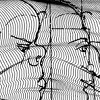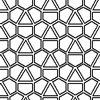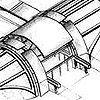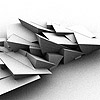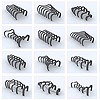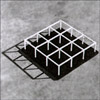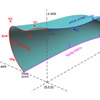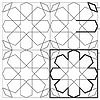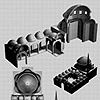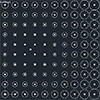In the 14th century, Albrecht Dürer basically seems to capture some of the fundamentals of contemporary parametric design. Apart from other thinkers of his age, he refused to accept one single definition of beauty, based on proportions. His famous physiognomical studies reflected very early examples of referential systems that generate diverse design outputs, even a half-century before Descartes published the coordinate system and four centuries before D’Arcy draw the formal […]
Posts categorized under Publications
Below is another cult article written by Robert Aish in 2005; Design has been described as making inspire decisions with incomplete information. True, we may use prior knowledge, we may even think we understand the causalites involved, but what really matters is exploration: of new forms, of new materials, and speculation about the response to the resulting effects. Essentially, this exploration has its own dynamics, involving intuition and spontaneity, and […]
Here is my 2004 Turkish translation of the popular article “Deleuze and the Use of the Genetic Algorithm in Architecture” by Manuel DeLanda in 2001. The computer simulation of evolutionary processes is already a well established technique for the study of biological dynamics. One can unleash within a digital environment a population of virtual plants or animals and keep track of the way in which these creatures change as they mate and pass […]
The exploration of the concept of “patronus – pattern” in architecture is presented in a captivating and insightful manner. This issue of AD, although older, continues to hold relevance in the contemporary realm of architectural design, covering various aspects of the conception and utilization of patterns. It’s comprehensive analysis and thought-provoking discourse shed light on the intricate relationship between patterns and architectural form, unveiling the potential for pattern-based design approaches […]
This is an old research paper, prepared with Birgül Çolakoğlu. It is in Turkish and includes our first results in some of the Rhinoscript exercises. Here is the abstract of the paper; Recent research in architecture have focused on to understand computational methods of formal exploration and expression. Computational mechanisms have been used to readdress formal issues using new techniques and methods. Computational tools that operate on algorithmic logic are central in […]
One of the cult texts in Shape Grammars theory is Stiny‘s Chinese Ice-ray Lattices Grammars. Although it is full of technical terms, it represents an analysis of a working algorithm. We can directly transfer that from the behavior of an artist. “One can imagine a Chinese artisan, summoned to a building site. He brings tools and implements and a collection of finely finished sticks. Then, he begins his design by […]
This month became a retrospective for me. This was my first animation, prepared for the CAAD Graduate course of Ahmet Turan Köksal in 2002. It was a funny inspiration from SDF-1 of Robotech. The terminal model is my graduation project at YTU Faculty of Architecture in 2001. It was a terminal bus project for İstanbul modeled in AutocadR14. I mirrored it with a ground plane to create the space station. Other spaceships and […]
Below is a part of Heidegger’s famous text, “The Question Concerning Technology”, on Techne, Epistinio, Poiesis; Revealing “… We are questioning concerning technology, and we have arrived now at Aletheia, at revealing. What has the essence of technology to do with revealing? The answer: everything. For every bringing-forth is grounded in revealing. Bringing forth, indeed, gathers within itself the four modes of occasioning – causality – and rules them throughout. […]
After explaining the beautiful parquet deformations of William Huff, Douglas Hofstadter states his opinions about the algorithmic potentials of those patterns. Although it was 30 years ago, Hofstadter points out a fundamental discussion related to today’s parametric design tools; …for a machine to make simple variants of a given design, it must possess an algorithm for making that design which has explicit parameters; those parameters are then modifiable, as with […]
In 2007, we conducted a computational design studio in YTU / CADU with Birgül Çolakoğlu. Below is the brief of the paper published at METU JFA Vol24 issue 2 titled “An Innovative Design Education Approach: Computational Design Teaching For Architecture”. We were dealing with how new technologies are affecting the design cycle. Rhinoscript is used as an educational tool, and various short exercises are conducted with it. After 6 years, […]
Architectural education in its relation to computational technologies is both becoming a part of these studies and having the potential of renovating itself with the knowledge of emerging technologies. This paper, in this framework, will be presenting a design research studio that aims at developing relational thinking capabilities in the computational design process. In this studio, topics of parametric design, parametric modeling, and relationality were questioned through the design process. […]
This simple tool, N-Grid resembles John Hejduk and colleagues’ famous design exercise “The Nine-Square Grid”. I developed the tool in 2009 using MaxScript. The nine-square grid is one of the most common kit-of-parts exercises in design studios for over 50 years. To explain briefly, the nine-square grid exercise is based on transforming a nine-square grid into a series of alternatives. The nine-square grid is an open-ended educational application with a limited but flexible context. It […]
From the 2009 eCAADe paper presented with Birgül Çolakoğlu titled; “Designer as Casual Coder: Overview of an Experimental Design Studio”; In recent years, computational approaches in architecture started to change the scope of the architect’s work. He/she is not any more a passive tool user instead, became a casual tool developer. Conventional CAD systems that focus on geometric representation of a designed artifact, are transforming into systems in which the […]
It was the 2008, eCAADe Presentation at Antwerp together with Birgül Çolakoğlu and Serkan Uysal. This paper presents a student work developed in the Introduction to Computational Design graduate course titled “Designing the Design” at Yildiz Technical University. The course focuses on the use of algorithms as design tools, rather than coding experiments. The course runs parallel to the shape grammar course. There, we study the basic concepts of computation […]
Studio exercises are short-term and open-ended design activities that represent a constructivist learning approach by limiting design domains. They are student-centered, model and process-oriented educational tools. These qualities make studio exercises potential tools for integrating contemporary Digital Design thinking into architectural education. This research aims to reveal these potentials by defining an analytical perspective and logical connections between the pedagogical intentions of studio exercises and the theory of Digital Design. […]
Under the dust of 10 years; revisiting my master’s thesis; This paper introduces research about the Computer Aided Instruction (CAI) tool which is based on the master thesis of Tuğrul Yazar from Yıldız Technical University (YTU) Faculty of Architecture Computational Design Graduate Program (BOM). The thesis is named “Expert Systems for Architectural Education: The Expert System of Sinan Mosques” and was completed in 2003 under the supervision of Dr. Birgül […]
This started as a pragmatist search of the term “Objectile”. I was curious about the real meaning of it, while the famous 1995 works of Bernard Cache were the thing I was looking for as images. I found two things about this word. One of them is the reproductions and online marketing of those famous carved panels (I was searching for), and while the second thing was a very interesting […]
Here is an interesting phrase from Jill Larkin and Herbert Simon’s famous article. It is “Why A Diagram (Sometimes) Worth Ten Thousand Words”; The phrase from the article We consider external problem representations of two kinds. Both of which use a set of symbolic expressions to define the problem. The fundamental difference between our diagrammatic and sentinential representations is that the diagrammatic representation preserves explicitly the information about the topological […]
This is my first try at DesignScript syntax. It is quite easy to understand and on-screen reference help seems to work well. It creates regular AutoCAD entities when you run. One of the most important concepts of this language is said to be a kind of associativity that updates objects when any parameter is changed while the script is running. However such associativity is not possible after the script has […]
Nowadays I plan to enter Rhinoscript, Python, and DesignScript back again. However, I can’t leave Grasshopper3D without mentioning the “cognitive shift” it pioneered in the design computing community. Here is a phrase from a famous special issue of “Computer” Journal, published in 1982 with Tilak Agerwala and Arvind’s editorials; Data flow languages form a subclass of the languages which are based primarily upon function application (i.e., applicative languages). By data […]

